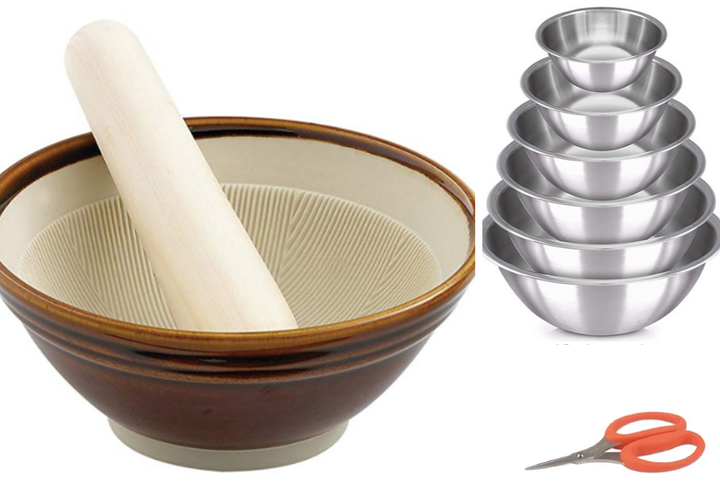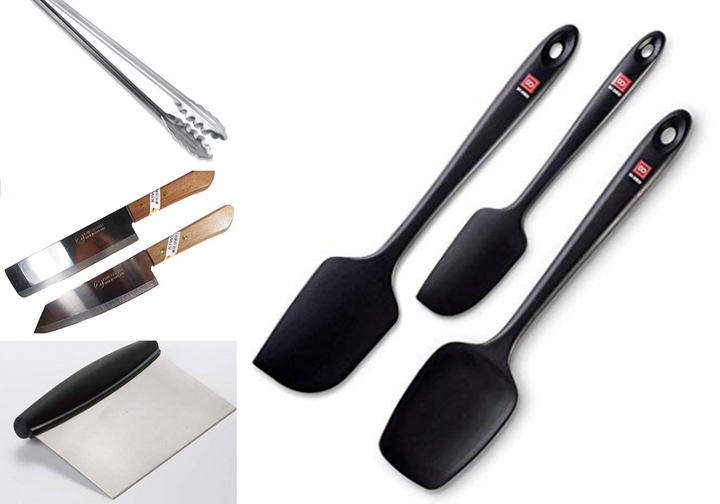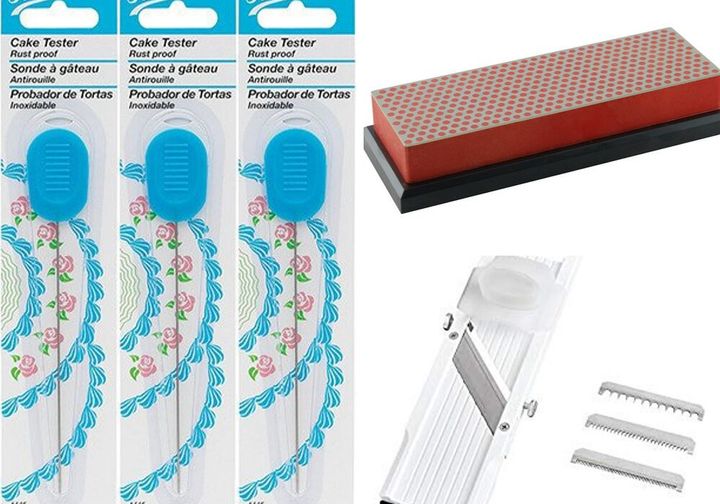Professional chefs get to work with some of the best equipment on the market — it is their job — but for the average home cook, shelling out hundreds of dollars for knives, pans and other cooking essentials just isn’t realistic. Thankfully, there are quality tools out there that get the job done without breaking the bank, and several of them are chef staples both at home and in restaurant kitchens.
We asked chefs across the country to share with us their favorite under-$50 kitchen tools. Here’s what they had to say.

Kitchen scissors
David Elkins, executive chef at Murray’s Cheese in New York, uses his fine dining experience to elevate the culinary programs of the cheese and specialty foods retailer. His favorite affordable kitchen tool, a good pair of kitchen scissors, is an essential for both professional and home cooks.
“I love this pair in particular because they are strong enough to cut through bones or shells when cleaning poultry, fish or shellfish, and small and sharp enough to be used in more delicate tasks like cutting herbs, parchment paper, cheese cloth or just about anything else,” Elkins told HuffPost.
Metal mixing bowls
John Lechleidner, chef de cuisine of WP24 by Wolfgang Puck at The Ritz-Carlton in downtown Los Angeles, has spent nearly 20 years refining his craft with the Wolfgang Puck Fine Dining Group. He told HuffPost that one of the best cooking implements you can have is a set of metal mixing bowls, as they are “probably the most used, abused, versatile and underrated tool in the kitchen.”
“You want [mixing bowls] that are wide and shallow, as they work better for whisking and folding, as well as using on double boilers to melt chocolate, make pastry creams, etc.,” Lechleidner said. “Stay away from the ones that have silicone bottoms, as they are usually too deep and flat on the bottom and you need to be cautious about putting [them] over heat.”
Mortar and pestle
James Syhabout, executive chef and owner of three Bay Area restaurants including the two-Michelin-starred Commis, also wrote a book that pays homage to his Isan Thai and Lao heritage. His budget-friendly kitchen tool of choice takes fresh herbs and spices to the next level.
“Aromatize your kitchen by pounding fresh herbs and toasted spices with this mortar and pestle, which is significantly superior to a coffee grinder or food processor,” Syhabout told HuffPost. “A humble kitchen tool, the mortar and pestle shouldn’t be underestimated. Unlike a blender, which merely chops, [a mortar and pestle] grinds, crushes, pulverizes, breaks down fibers [and] bruises to release and extract essential oils and juices. It is also a great workout for your arms to boot.”

Bench scraper
Erin Wade, chef and owner of Homeroom, a mac and cheese restaurant in Oakland, is also a cookbook author and founder of Not On The Menu, a sexual harassment prevention project. Her affordable kitchen staple helps keep food off the kitchen floor when cooking.
“I had used a bench scraper for many years for pastry, but a few years ago I started using it to move chopped items from one place to another,” Wade told HuffPost. “I know it sounds a little extreme, but this changed my life. Or at least, it changed the debris level on my kitchen floor. It has a wide metal face that collects food effortlessly, leaves the cutting board clean, and is not prone to spilling. Also, it costs like ten bucks. Basically, it’s the best.”
Chef’s knife
Gil Payumo is the co-founder and culinary director of Señor Sisig, a fleet of Filipino fusion food trucks in San Francisco that is adding a brick-and-mortar store to its lineup this fall. His affordable kitchen tool of choice proves you don’t need to pay a lot of money for a quality knife.
“This [Kiwi] knife is what I’ve always had in the knife drawer in my kitchen growing up,” Payumo told HuffPost. “The blade is super sharp and can cut a fully ripe tomato better than any other knife in my bag. Before culinary school, I thought it was crazy [that] anyone would have to spend at least $100 to get a decent knife. Don’t get me wrong, I have a couple pricier knives in my knife bag right now, but I still have this knife ready for any challenge it has to endure. This is the tool I used almost 20 years ago when I started cooking, and it’s still going strong slicing and dicing the competition.”
Stainless steel tongs
Lachlan Sands, campus president at the Institute of Culinary Education in Los Angeles, has been in culinary education for nearly two decades. When it comes to affordable kitchen recommendations, Sands is all in on the 12-inch heavy-duty tongs by Edlund.
“These aren’t the flimsy, thin, flat-ended knock-offs you might be used to,” Sands told HuffPost. “They are a precision instrument capable of extreme delicacy and mass clutching. They grip, stir, scrape, flip, poke and place. Strong and durable, mine have lasted 20 years and counting. They are an indispensable extension to my hand while cooking.”
Silicone spatula
Henry Wesley is the executive chef of 8UP, a hip rooftop restaurant in downtown Louisville, Kentucky. His must-have kitchen tool is a high heat silicone spatula.
“It can be used for anything from flipping omelets to scraping cake batter bowls,” Wesley told HuffPost. “They are absolutely essential in the restaurant for saving money on food waste and essential at home as well. Plus, they won’t scratch up your pans like a metal instrument and you can put them in the dishwasher, unlike wooden spatulas.”

Mandoline
Susan Feniger, co-chef and owner of the Border Grill restaurants in Los Angeles and Las Vegas, is opening a new restaurant in Santa Monica called Socalo this fall with longtime business partner Mary Sue Milliken. Her most-loved kitchen tools when cooking at home are a vegetable peeler, ginger grater and mandoline.
“I love the mandoline because I’m so used to having grown up in a French kitchen and an inexpensive mandoline, like the Benriner, is perfect for shaving vegetables fresh out of my garden,” Feniger told HuffPost. “My favorite thing is to do a shaved vegetable quick pickle to serve alongside curry.”
Knife sharpening stone
Fortunato Nicotra, executive chef of Felidia (Lidia Bastianich’s enduring New York City eatery), considers a sharp knife to be one of the most important tools in the kitchen. “A sharp blade makes a big difference when you slice meat or fish,” Nicotra told HuffPost. “It makes cutting precise and doesn’t squeeze the juice out of whatever you’re slicing.”
To keep his knives sharp, he uses a DMT 6-inch diamond whetstone. “Diamond stones cut very fast; the unique pattern in the surface traps the particles while I’m sharpening my knife, getting the shaved metal out of the way and speeding up the sharpening time.”
Cake tester
Nick Wong, a Momofuku Ssam Bar alum, moved to Houston to help open UB Preserv, where he now works as the chef de cuisine. And his favorite cheap kitchen tools — Ateco cake testers — can fill many needs beyond their original purposes.
“In our kitchen we use cake testers for testing doneness of foods without compromising the structural integrity of whatever we’re checking, from steak to potatoes,” Wong said. “We also use them to prick sausage casings when making sausages.”
Wong added that the number of times he’s had to repurchase these cake testers speaks to their usefulness in the kitchen. “The true test of an industry standard tool is how many times you’ve had to replace it,” he said. “When other cooks ‘accidentally’ take your cake tester or borrow one and forget to give it back, you don’t just go without. You buy some new ones or you get yours back from someone else. [But] if you’re in a real situation, a straightened paper clip also works in its place – or so I’ve heard.”
HuffPost may receive a share from purchases made via links on this page.